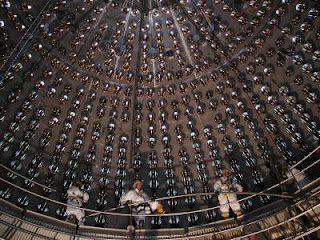Scientists have discovered antimatter like particles deep under the Earth's surface. The particles that were discovered are called geoneutrinos. Geoneutrinos are lightweight, neutrally charged particles, that are the antimatter counterparts of neutrinos.
Antimatter holds pretty much the opposite properties of regular matter. For example, If just an ordinary particle, say an electron, collides with an antimatter particle--They will explode. Antimatter is sometimes referenced to as the "god particle" and for good reason. With just around 1 kg of antimatter, you could create an explosion big enough to match that of the Tsar bomb, which is the world's most powerful nuclear weapon. Although, the discover of these so called "antimatter particles" are not actually antimatter. They kinda are similar in the sense that geoneutrinos are the opposites of neutrinos, like how antimatter is the opposite of matter.
Deposits of these antimatter particles is caused by radioactive decay of thorium, uranium, and potassium from the Earth's crust and mantle.
The discovery originated at the Gran Sasso National Laboratory of the Italian Institute of Nuclear Physics. They used a giant steel sphere that is buried about a mile under Gran Sasso moutain in Italy. The sphere has a inner nylon sphere detector that holds 1,000 tons of hydrocarbon liquid. It then has an outer steel sphere which contains ultra-sensitive photodetectors and then the whole thing is encased in another steel sphere (45 ft diameter) that holds about 2,400 tons of purified water. The thing is designed to only detect solar neutrinos, geoneutrinos and neutrinos. After an entire year of searching for the geoneutrinos particles, only a few were found. However, solar neutrinos are relatively common as the sphere can detect them more easily. Geoneutrinos, on the other hand, are very difficult to find as they can pass through everything without any kind of interaction whatsoever. The research is still ongoing.
Studying geoneutrinos could help researchers better understand the way heat develops and flows under our planet and how it can affect events like volcanic eruptions and earthquakes.
Photo credit: Paolo Lombardi INFN-MI
Story Adapted from: Livescience
Related Posts:
Scientists Claim Humans Will Become Extinct In 100 Years
The Solar Storm That May End It All In 2013
>>a bit of science, tech, art, and weird
Pages
Labels
- albert einstein
- Aliens
- Animals
- asteroids
- Astronomy
- Biology
- Books
- Curiosity
- einstein
- Electronics
- End of Worlds
- Enviromental Science
- Extreme Weather
- Future Cars
- Future Technology
- Future Weapons
- futurism
- Gadgets
- Gaming
- Geeky
- Green Technology
- Immortality
- Is It Real?
- Life Extension
- Lightning pictures
- Mad Science
- Mars
- michio kaku
- Most popular
- must reads
- Must See Videos
- NASA
- NASA News
- News
- No Freakin Way!
- Photo Gallery
- Pictures
- planets
- quotes
- recomended books
- Robot News
- Robots
- Science
- Science Fiction
- Science Fiction Movies
- Science News
- scientist pictures
- scientists
- Space
- Space and Astronomy
- Space News
- Space Pictures
- Star Wars
- store
- Stuff For Geeks
- Technology
- Technology News
- The Future
- The Unexplained
- Videos
- Virtual Reality
- Weather
- WTF Future?
About TimeHuman
This blog is written by independent researcher/writer Simon Gallings. As such, it will contain many bits on subjects like: space, future tech, robotics, strange science, animal behavior, and much more.
Mission statement: to help spread scientific knowledge and to create interest and enthusiasm in the sciences.
------------------------------------------------
Popular this week...
-
Okay, so maybe the "Tvor" isn't actually a "pet lamp" but it does have the ability to seek out dark areas of a room...
-
A study currently being conducted by University of South Carolina researchers suggests that brain damage from a stroke might not be so perm...
-
What do you get when you combine a jet engine with a VW Beetle? Well, you get what Mr. Ron Patrick created -- this awesome baby! Now asi...
-
Convert your iPhone into an alien shooting machine with the Appgun. The app will be release in April at a cost of about $30 and comes with a...
-
Oliver Kreylos is at it again, hacking the Kinect into a real holographic 3-D video chat system. Watch the video below to see the hologr...
Powered by Blogger.


